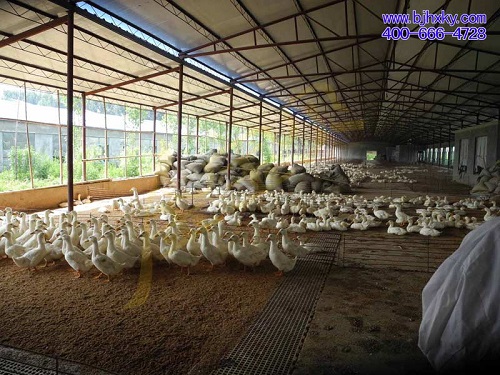Fermentation bed culture technology refers to the comprehensive utilization of the principles of microbiology, ecology, and fermentation engineering, and the use of active functional microorganisms as an ecological breeding mode for material energy. The core of the technology lies in the use of a powerful microbial compound flora with beneficial functions, long-term and sustained and stable conversion of animal waste into useful materials and energy, and at the same time achieving complete degradation of excrement from ducks and other animals to achieve no pollution. Zero emissions goals. Breeding ducks in a fermentation bed can enhance the disease resistance of meat ducks, improve the breeding environment, and increase the comprehensive benefits of meat ducks. Here we will introduce a meat duck breeding technique using the example of the Jinbao Dry Fermentation Bed Bacteria (please click here for details).

2. The management of broiler duck brooding in the fermentation bed is well done. Such as ducklings spread out, no strange calls, indicating that the temperature is suitable; such as ducklings shrinking neck and shriveling, stacked near each other near the heat source, indicating that the temperature is too low; such as ducklings away from the heat source of drinking water increases, then the temperature is too high. It is necessary to separate groups in a timely manner to prevent them from getting together. When brooding, it should be divided into several small groups according to size, strength, age, etc. to facilitate feeding and management. Adjust once a week. In order to prevent ducklings from being crowded with each other, it is particularly important to prevent the occurrence of crowded deaths within 10 days of age. To control diet, feed 5 to 6 times per day and night within 10 days of age, 3 times during daytime at 11 to 20 days, and 3 times during the day and 20 days after night.
3. Fattening and fat management of meat ducks The bed is opened 3 to 5 days ahead of time when fattening and turning, so that the ducklings gradually adapt to the outside temperature. If the outside temperature is low or the temperature changes irregularly, it will be postponed for several days. At this time, a variety of vitamins are added to the feed to prevent the effects of swarming until the ducks feed normally after the swarm. In addition, transfer must be done on an empty stomach. When de-warming and transferring to groups, they should be reared in groups of different sizes and sizes, and the number of each group should be controlled to 200. Ducks with poor physique and lighter weight were given nutritional supplements alone, which allowed them to rapidly grow and develop in the later stages. After 4 weeks of age, the meat ducks were fed diets to reduce crude protein levels and increase sugar content. Feed replacement should be gradual. After entering the stable fattening period, the fattening duck house requires dimming and keeping the surrounding environment quiet. Appropriately limit the activities of the meat duck to ensure sufficient feed, so after 2 weeks of feeding, it can increase about 1 kg.
4. Meat duck fermentation bed disease defense vaccination. Duck plague, duck viral hepatitis, and duck cholera are common diseases in ducks. On the one hand, ducklings can be vaccinated against attenuated duck plague vaccine; if duck pupa occurs, anti-duckling hyperimmune serum can be injected at the early stage of the disease. The prevention of aquaculture is the mainstay. To prevent the occurrence of diseases, terramycin, fluorosalicylic acid, and ciprofloxacin can be added to the material. Or add traditional Chinese medicine preparations such as Codonopsis pilosula, Astragalus membranaceus, Radix Isatidis, Folium Isatidis, etc. to improve their immunity. Management details can be consulted: Beijing Huaxia Kangyuan Technology Co., Ltd. Telephone toll-free hotline
Causes of Riemerella anatipestifer disease and prevention and treatment methods Probiotics in fermentation bed culture help livestock and poultry to improve intestinal conditions
Pathological Diagnostic Solutions
LBC, AI-assisted Diagnosis, Pathology Slide Scanner
HANGZHOU DIAN BIOTECHNOLOGY CO., LTD. , https://www.dianbiotech.com